Create services
Services represent your microservices and other workloads. Each service contains a Service Definition that defines your deployment artifacts, manifests or specifications, configuration files, and service-specific variables.
Create a service
You can create services from:
- Within a pipeline
- Outside a pipeline
- An account
- An Organization
If you are new to Harness, review Harness key concepts and create your first CD pipeline.
- Within a pipeline
- Outside a pipeline
- From organization or account
To create a service from inside of a pipeline, select the Services tab of a new CD stage, then select New Service.
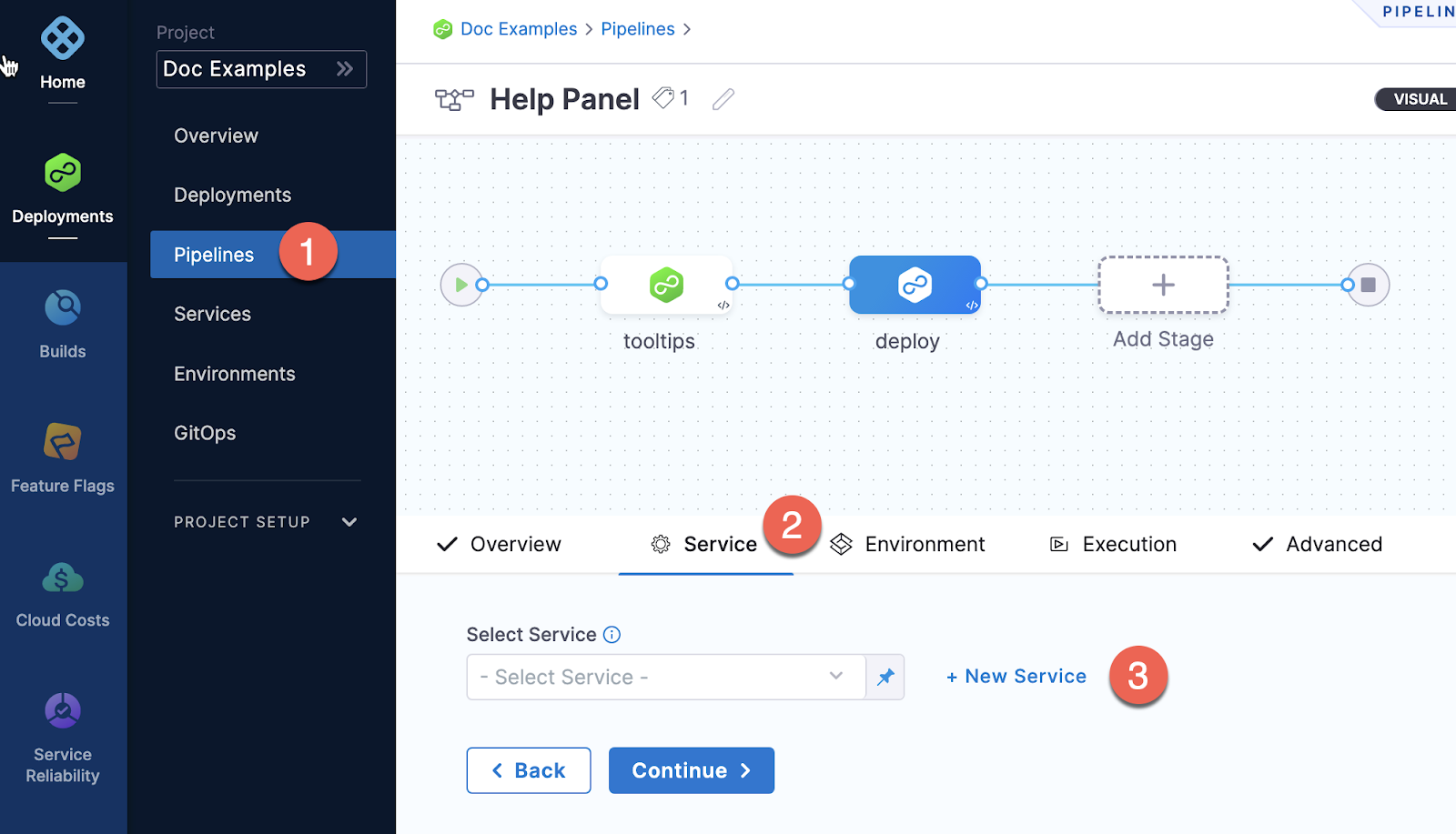
Once the service and its service definition are saved, you can select it in any pipeline.
When you select the service in a pipeline, you can select Edit Service to edit its Service Definition.
When you create the new service you define its Service Definition. For example, a Kubernetes Service Definition with a Kubernetes manifest and Docker artifact.
To create a service from outside of a pipeline, you use Services in the navigation pane.
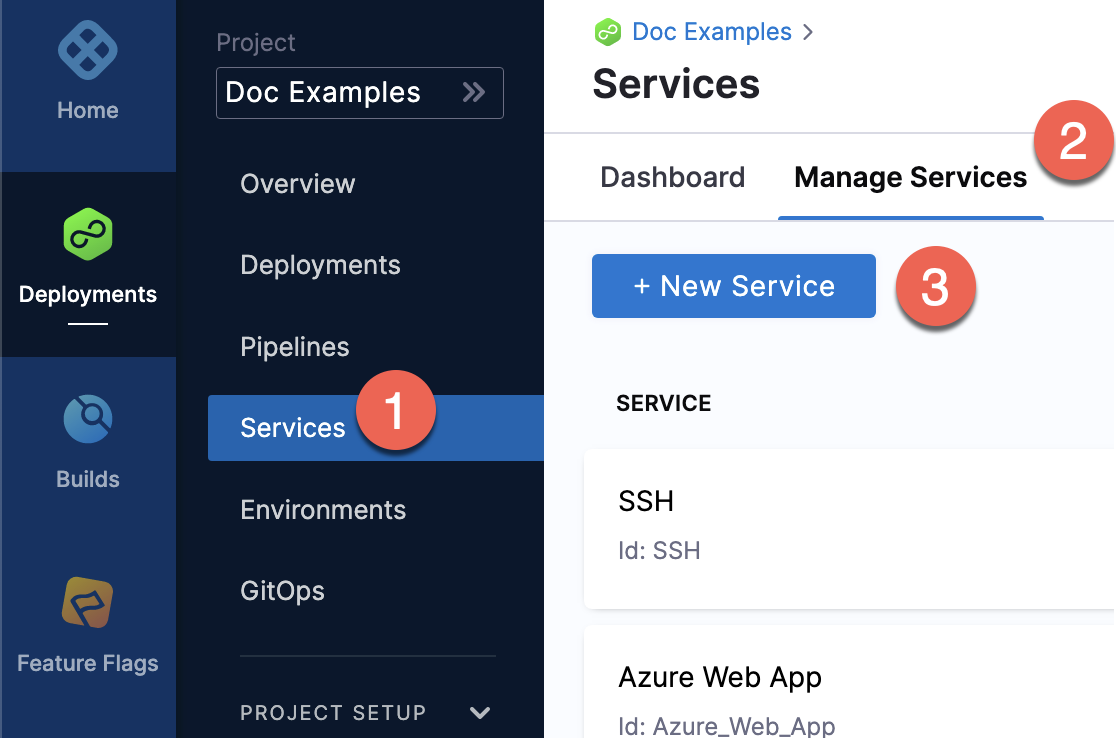
You can create a service at an account or organization level from the Pipeline Studio, APIs, or Terraform.
- Pipeline Studio
- API
- Terraform
To create a service at an account or organization level, go to Organization Resources >Services.
Creating an account level service enables you to manage the service globally across the organizations and projects within the account.
An account level service can only reference connectors for the manifests and artifacts within the account. These services are global and cannot have dependencies at a lower hierarchy level.
Shared services can also be created and managed at account or organization levels.
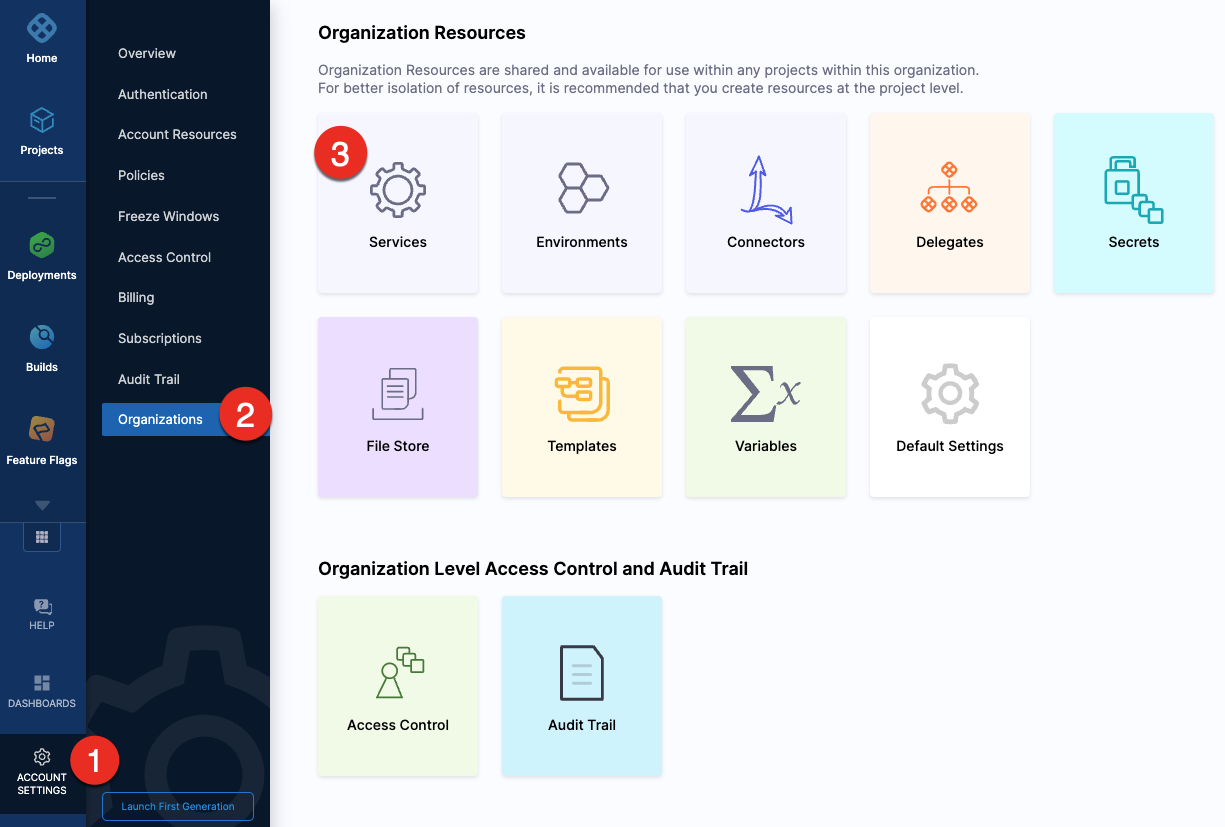
When using an account level deployment stage template, you can referencing an account level service only. Similarly, for organization level stage templates, you can reference organization level services only.
However, when using a deployment stage in a pipeline that has service configured as a runtime input, you can pick services from project, organization, or account levels to pass them as runtime inputs based on your RBAC.
Go to add a stage template for more information.
Expand the section below to see a sample account level service YAML.Account level service YAML
service:
name: nginx
identifier: nginx
tags: {}
serviceDefinition:
spec:
manifests:
- manifest:
identifier: nginx-base
type: K8sManifest
spec:
store:
type: Github
spec:
connectorRef: account.Harness_K8sManifest
gitFetchType: Branch
paths:
- cdng/
repoName: <+input>
branch: main
skipResourceVersioning: false
artifacts:
primary:
primaryArtifactRef: <+input>
sources:
- spec:
connectorRef: account.Harness_DockerHub
imagePath: library/nginx
tag: <+input>
digest: <+input>
identifier: harness dockerhub
type: DockerRegistry
type: Kubernetes
Expand the section below to see a sample organization level service YAML.Organization level service YAML
service:
name: redis
identifier: redis
tags: {}
serviceDefinition:
spec:
manifests:
- manifest:
identifier: redis
type: HelmChart
spec:
store:
type: Http
spec:
connectorRef: org.bitnami
chartName: redis
chartVersion: ""
subChartName: ""
helmVersion: V3
skipResourceVersioning: false
enableDeclarativeRollback: false
- manifest:
identifier: Redis Values
type: Values
spec:
store:
type: Github
spec:
connectorRef: account.Rohan_Github
gitFetchType: Branch
paths:
- redis/values.yaml
repoName: Product-Management
branch: main
variables:
- name: namespace
type: String
description: "namespace for the redis service"
value: redis
type: Kubernetes
description: sample redis service
For information about creating a service API, go to create a service.
The orgIdentifier and projectIdentifier field definitions are optional, and depend on where you want to create the service. For example, if you create a service at an account level, you will not need org or project identifiers in the post API call payload.
For information about creating a Harness platform service, go to harness_platform_service (Resource).
The org_id and project_id field definitions are optional, and depend on where you want to create the service. For example, if you create a service at an account level, you will not need org or project identifiers.
Expand the section below to see a sample platform service in Terraform.Harness platform service
resource "harness_platform_service" "example" {
identifier = "identifier"
name = "name"
description = "test"
org_id = "org_id"
project_id = "project_id"
## SERVICE V2 UPDATE
## We now take in a YAML that can define the service definition for a given Service
## It isn't mandatory for Service creation
## It is mandatory for Service use in a pipeline
yaml = <<-EOT
service:
name: name
identifier: identifier
serviceDefinition:
spec:
manifests:
- manifest:
identifier: manifest1
type: K8sManifest
spec:
store:
type: Github
spec:
connectorRef: <+input>
gitFetchType: Branch
paths:
- files1
repoName: <+input>
branch: master
skipResourceVersioning: false
configFiles:
- configFile:
identifier: configFile1
spec:
store:
type: Harness
spec:
files:
- <+org.description>
variables:
- name: var1
type: String
value: val1
- name: var2
type: String
value: val2
type: Kubernetes
gitOpsEnabled: false
EOT
}
Using runtime inputs and expressions with services
Services are often configured using runtime inputs or expressions, so you can change service settings for different deployment scenarios at pipeline runtime.
For more information on runtime inputs and expressions, go to Fixed Values, Runtime Inputs, and Expressions.
Often, the service option in a pipeline is also set as a runtime input, so you can select which service to use when you deploy the pipeline.
Also, the pipeline that deploys the service might be triggered in response to changes in a service's artifact or manifest.
There are a few things to note when using services with or as runtime inputs:
- Service runtime inputs are not configurable in the pipeline that deploys the service.
- Service runtime inputs are not configurable in the trigger.
Why are service inputs not configurable?
Many Harness settings and options are dependent on the specific values set in a service. When a value is set as runtime input, Harness can't identify what configurations to render in the user interface.
Selecting settings when the service is an expression
If you use an expression in a service setting, Harness must be able to resolve the expressions when you run the pipeline using the service.
There are a few options you can use to support expressions when a service is set as a runtime input in a pipeline, or when the service itself uses runtime inputs. These options are covered in the following sections.
Use trigger payload data to configure the service at runtime
You can pass in this data when the pipeline execution is triggered using a custom cURL trigger.
For more information, go to Passing data in Custom triggers.
Here's the YAML for a service in a pipeline that uses trigger payload data for the service reference, primary artifact, and tag:
spec:
service:
serviceRef: <+trigger.payload.serviceId>
serviceInputs:
serviceDefinition:
type: TAS
spec:
artifacts:
primary:
primaryArtifactRef: <+trigger.payload.artifactId>
sources:
- identifier: <+trigger.payload.artifactId>
type: Nexus2Registry
spec:
tag: <+trigger.payload.tag>
To supply the data, you simply provide the payload key-value pairs in the cURL command you use to execute the pipeline:
curl -X POST -H 'Content-Type: application/json' --url 'webhook_url' -d '{"serviceId": "Kubernetes", "artifactId": "nginx", "tag": "abc"}'
Use pipeline variables and trigger payload data to configure the service at runtime
You can create pipeline variables and map those to service settings. When you run the pipeline, you can provide values for the variables to define the service.
For example, here are pipeline variables for a service's artifact and tags.
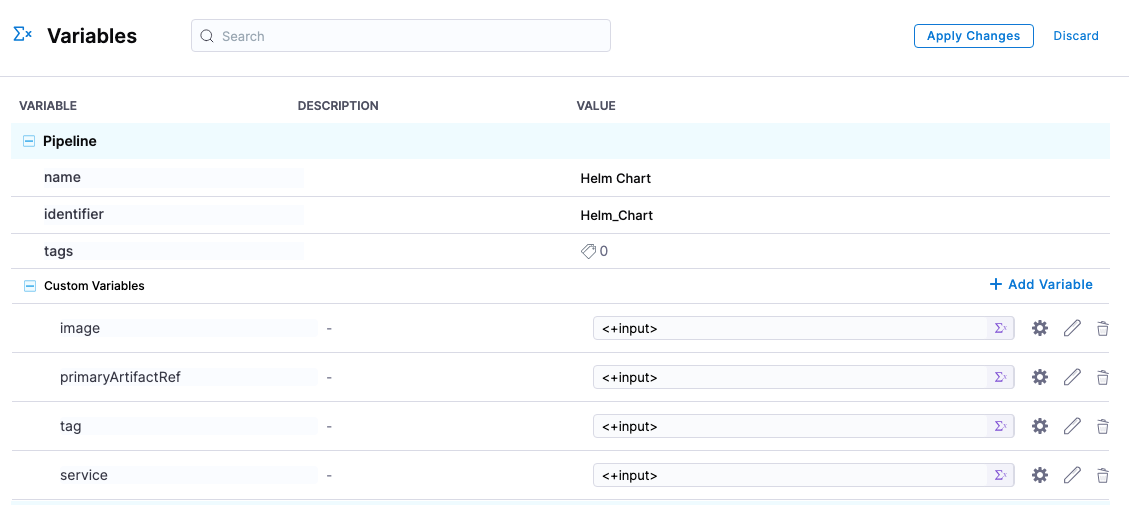
Next, you map the pipeline variables to the services' artifact settings using expressions:
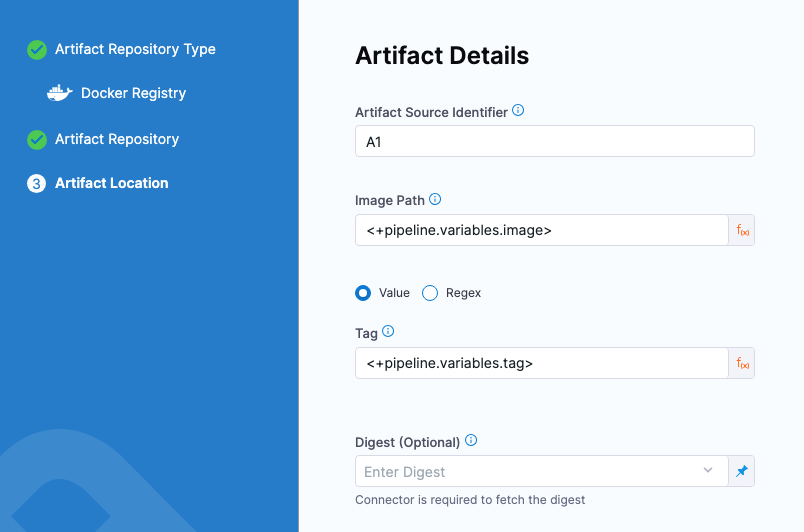
You can also map a pipeline variable for the service name as an expression:
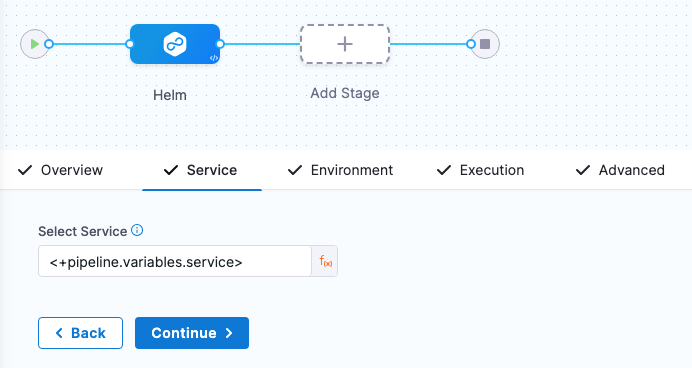
When you run the pipeline, you are prompted to provide values for the pipeline variables.
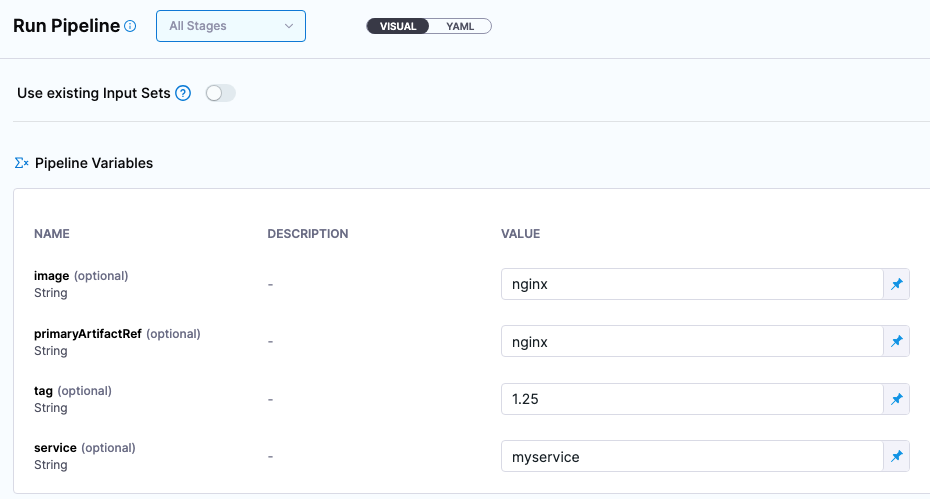
You can also map these same pipeline variables to trigger payload data expressions.
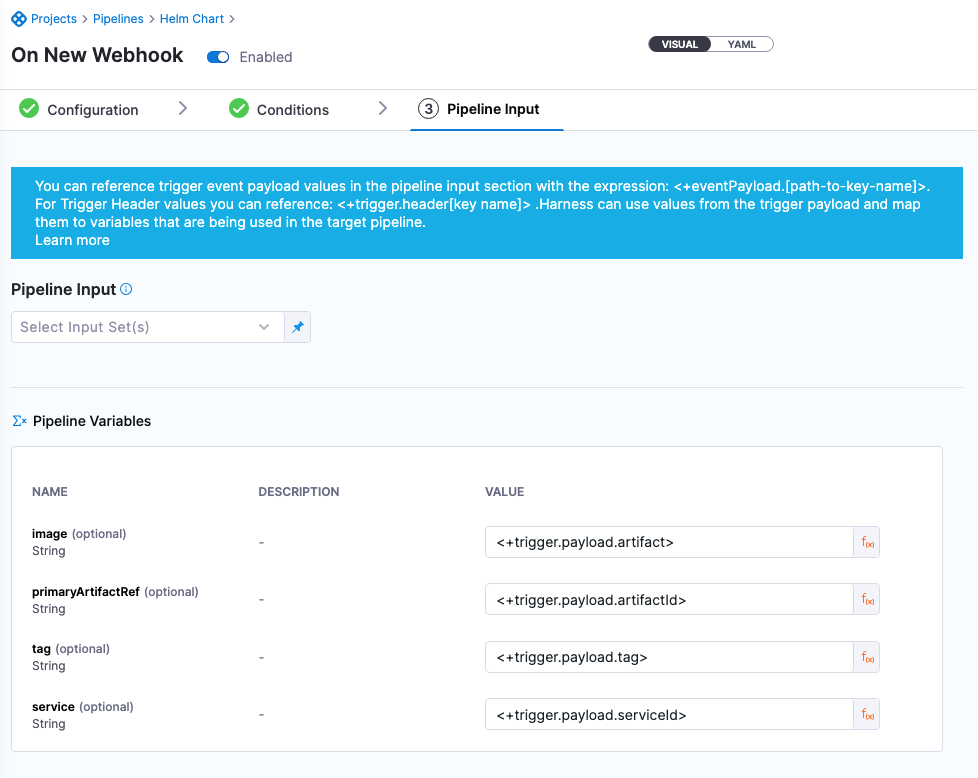
When you initiate the trigger using the cURL command, the key-value pairs in the command are used for the pipeline variables. Finally, those pipeline variable values are used to define the service.